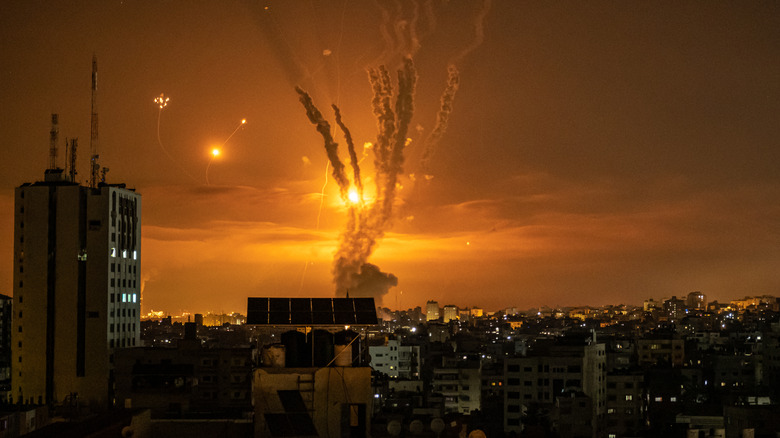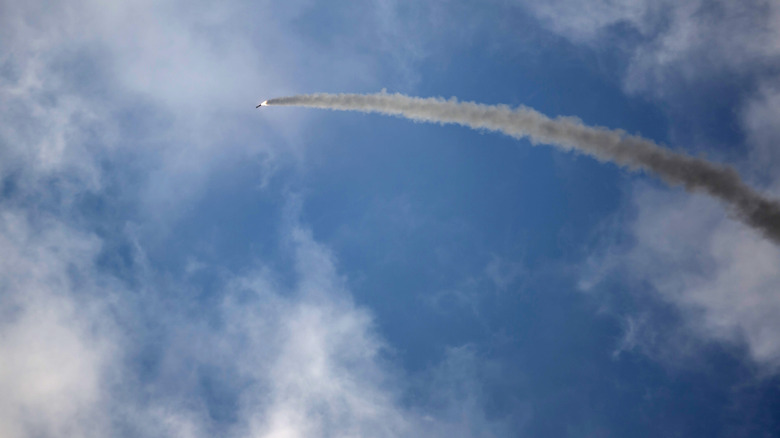What Is Israel's Iron Dome (And How Does It Work)?
Ever since Israel became a sovereign nation in 1948, it has contended with conflict. The Arab-Israel Wars started the very year the country was created and recurred in 1956, 1967, 1973, 1982, and 2006, pitting nearby countries against the U.S. ally. And of course, Israel has faced unending civil strife and conflict with the two Palestinian-inhabited territories it occupies: the Gaza Strip and the West Bank. In between it all, the Islamic militant terrorist group Hamas struck out at Israeli citizens again and again, and in 2007 took the entirety of the Gaza Strip, the western territory of Palestine along the Mediterranean Sea. Meanwhile, countries like Iran fund Hamas and supply it with advanced rocketry that rains down on Israel, as Counterterrorism Ethics explains.
The reader may well wonder: If Israeli citizens are at daily risk of death from the skies, why isn't every single patch of ground in Israel already blasted apart by rockets, mortar shells, drones, and such? This brings us to one of the most critical parts of modern warfare: ground-to-air defense technology. In general, a surface-to-air missile (SAM) is the most common way to take down a missile en route to a target. This is, essentially, our only recourse for defending from such airborne attacks — no sci-fi forcefield domes yet.
But while Israel doesn't have a forcefield dome encasing the country, it does have its Iron Dome — a defense network of 10 batteries of SAM launchers placed strategically around the country. The Iron Dome shields citizens from destruction, is extremely effective, and has saved untold numbers of Israeli lives.
A nimble, maneuverable sky defense system
"Iron Dome" is the perfect image to envision when thinking of Israel's missile defense system. But rather than a solid piece of metal, the "dome" is a range, and the system intercepts whatever seeks to infiltrate this region. Outlining how the whole system works, CNN says that each of the dome's 10 missile batteries houses three to four missile launchers. Batteries detect incoming projectiles — missiles, mortar shells, drones, etc. — of a distance ranging from 2.5 to 43 miles and relay information about the projectile's likely target to a command center. If the projectile is headed for an area with no people, it's allowed to pass through the dome. If not, the dome shoots a missile to intercept the incoming attack. If there are multiple incoming projectiles, the system determines an order of relevance and intercepts whichever ones will do the most damage to people and property first.
One of the most versatile features of the Iron Dome is its maneuverability and ease of arrangement. Each missile battery is mobile and can be transported to where it's needed most. When set into place, the whole thing can be activated and ready in a matter of a few hours. The dome's Tamir missiles themselves, as CNN continues, are long and surprisingly thin: 10 feet long vs. 6 inches in diameter. They're also fairly light — less than 200 pounds per missile — and very agile. About 24 pounds of each missile's weight is its explosives.
Protection for the future
As mentioned, Israel's Iron Dome has proven essential to the defense of its country. And yet, the system wasn't online until 2011. As CNN says, work on the Iron Dome began in 2007, tests commenced in 2008 and 2009, and the Iron Dome was activated in 2011. The BBC says that the dome — considered the world's most advanced surface-to-air defense system of its type — was developed by Rafael Advanced Defense Systems and Israel Aerospace Industries in tandem with the United States. The timing of its development — the year that Hamas took Gaza — was noncoincidental, and the system was designed to suit the type of armaments employed by Hamas terrorists in Gaza.
To illustrate how critical the Iron Dome is to Israel's safety, the BBC says that in Hamas' early October 2023 attacks, the system shot down about 90% of the 3,000-plus individual rockets in a single week. Elsewhere, the Israeli Defense Forces website says that in May 2023, the Iron Dome intercepted 95.6% of all missiles it intended to take down. As it stands, the only way to counter the Iron Dome would be to overwhelm it with numbers. Young people in Israel (seen above) have even taken to spectating Iron Dome defense launches, so sure is public confidence in the system.
In fact, the Iron Dome has been so successful that the Jewish Virtual Library says Israel has started selling the technology to other countries. Azerbaijan bought an Iron Dome in 2016, and India and Romania await their own.


